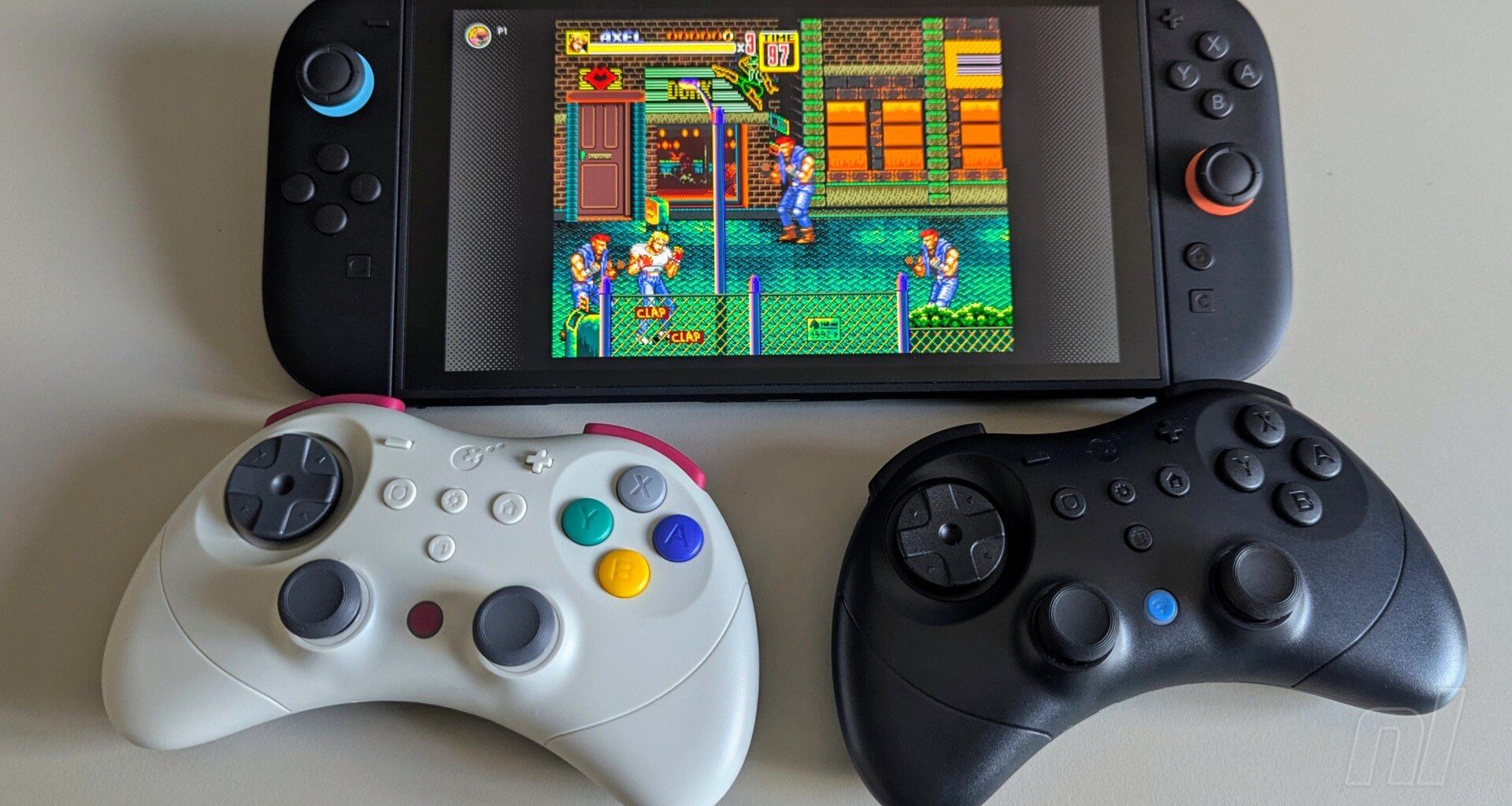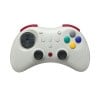 Image: Ollie Reynolds / Nintendo Life
Image: Ollie Reynolds / Nintendo Life
My first impression of the Gulikit Elves 2 Pro wasn’t particularly positive. Now, when I say ‘first impression’, I’m talking about the moment I laid eyes on the thing in a few press shots online. I suspect that some of you checking out the photos in this review might be thinking the same thing. Yes, the obvious throwback to the Sega Saturn is great, but does a controller of this design really hold any weight in the modern age?
Well, thankfully, the answer to that question is a hearty “Yes.” When the controllers arrived and I unboxed them from their translucent cases (a nice touch to add extra protection when travelling), I immediately fell in love. The coloured ‘Retro’ model in particular, based on the ‘Model 2’ Japanese Saturn, is absolutely gorgeous and a lovely homage to Sega’s Mega Drive successor.
The black variant is really nice, too, with the only hint of colour being the blue sync button in between the two analogue sticks. This, again, is a nod to the ‘Model 1’ Japanese Saturn, though the jet black casing is perhaps more akin to the Western design. Think of it like a blend of the two, then. The only downside with the black version is that dust is naturally more noticeable on darker surfaces, so it shows up a lot more than the ‘Retro’ version.
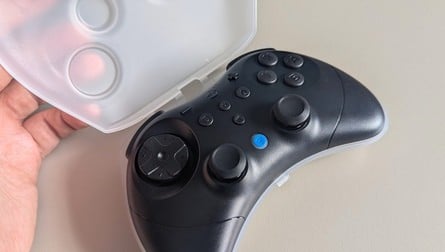
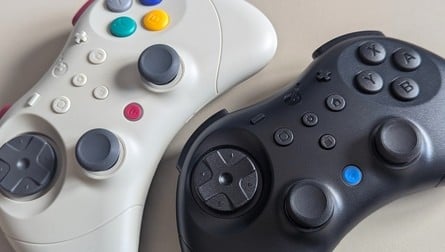 Images: Ollie Reynolds / Nintendo Life
Images: Ollie Reynolds / Nintendo Life
Holding the controller reveals just how well-made it is. It’s got a hefty weight to it: 190g to be exact. This is lighter than the Switch 2 Pro Controller and the 8BitDo Ultimate 2C controller — both of which weigh in at 235g — but the Elves 2 Pro is a lot smaller than both, so the weight/size ratio balances out nicely. It doesn’t feel cheap, let’s put it that way.
As for the shape, yes, it’s a little unorthodox by modern standards and you’re lacking the longer grips necessary to ‘hug’ it with your palms, but the curved design feels pleasant. It’s easy enough to move from the face buttons and D-pad to the two analogue sticks in the middle thanks to the offset positioning, though the former setup does feel slightly more natural.
Indeed, you can use this controller for almost any game on Switch or Switch 2, though to say that it’s best suited to retro titles or fighting games wouldn’t be inaccurate. The shape, the colours, the D-pad design: it all feels perfectly suited to retro gaming. For fighting games in particular, purists might lament the lack of the six-button setup on the Saturn’s controller, but I felt no concern when testing it out with the likes of Street Fighter 6 and Marvel Vs. Capcom Fighting Collection: Arcade Classics. The D-pad in particular feels great, but more on that shortly.
Looking at the analogue sticks, they utilise Hall Effect technology, so you’re theoretically looking at a long lifespan for the Elves. You can also easily remove the caps for replacement if necessary; I say ‘easily,’ but they do take a bit of effort to remove, and this is a good thing – you don’t want them coming off during regular play. They’re slightly smaller than your average analogue stick – maybe a fraction smaller than those found on the Switch 2 Joy-Con – and the textured grip around the edge is just begging to pick up grime from your thumbs over time, but overall, they’re really nice.
Images: Ollie Reynolds / Nintendo Life
The same goes for the ‘floating’ D-pad, too. In fact, I’d say the sensitivity for this is pretty spot on: holding down and rocking the D-pad from side to side yielded absolutely zero accidental inputs when testing it in the Switch settings, and the same can be said in retro titles like Streets of Rage 2 and Contra. It works exactly as intended and as you’d expect. If you want to go one step further, you can actually change the D-pad setup between four-directional and eight-directional, depending on the game you’re playing.
The face buttons and shoulder buttons all feel nice: pleasingly ‘clicky’ without producing a whole lot of noise. Again, a huge shoutout goes to the ‘Retro’ model here: the grey, green, blue, and yellow ABXY buttons look lovely, and I’ve grown really quite fond of the cranberry-coloured shoulder buttons and sync button. Much like the D-pad, you can fiddle with the settings to reassign inputs – pretty good if you’re not fussed about doing it on the Switch itself.
In fact, there are a lot of different settings you can play around with. You can adjust vibration intensity, analogue stick sensitivity, dead zone modes, motion aim assists, turbo mode, APG recording (which basically lets you record specific input combos and repeat them at will), and more.
This is all done via the ‘settings’ button located in the centre of the device (apart from APG recording, which has its own button just below). Holding the button down and pressing a corresponding button changes a specific setting. So, for example, ‘settings’ + ‘R3’ or ‘L3’ changes the sensitivity of the chosen analogue stick. There’s a lot to learn, so it’s worth reading and memorising each setting combination listed in the manual, but it’s nice that there’s no separate app to worry about.
Images: Ollie Reynolds / Nintendo Life
You’ve also got gyro support, three different rumble modes (including its own ‘HD Rumble’, which feels great), wired support with the included USB-C cable, and a capture button. But what’s missing?
Well, there’s no ‘C’ button for GameChat, no headphone jack, no NFC support, and no ability to wake the Switch 2 from sleep mode. These are all arguably ‘nice to have’ functions, and to be honest you’re never going to get a third-party pad that does absolutely everything. If you’re particularly concerned about the lack of ‘wake-up’ support, however, Gulikit has confirmed that it will soon be the first third-party manufacturer to offer such support, though how and when this occurs has yet to be revealed.
Finally, although the controller does turn off on its own after 15 minutes of inactivity, there’s a teeny, tiny button on the back to turn it off manually. This is a nice little touch that a lot of manufacturers don’t really consider. Of course, whether it will actually be of use to you is very much dependent on your own circumstances, but hey, it’s a good thing to have. The pad can also be used with PC and iOS, with a three-way toggle located just above the off button to switch between the three modes.
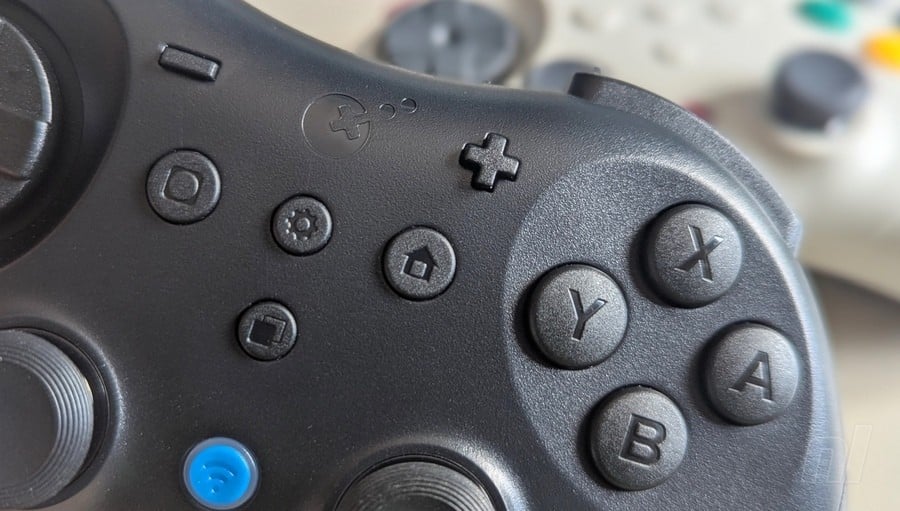 Image: Ollie Reynolds / Nintendo Life
Image: Ollie Reynolds / Nintendo Life
All in all, though, I’d say the Elves 2 Pro is probably best suited for retro games and fighting games rather than your go-to controller for everyday use. It’s an exceptionally well-made pad, and a fabulous alternative to Nintendo’s own SNES and Mega Drive NSO controllers. If you’ve got an affection for the Sega Saturn, the ‘Retro’ variant in particular is a wonderful throwback; just don’t be surprised if you start glancing down to admire it when you really should be keeping your eyes on the screen.
A lovely throwback to the Saturn
Well-made with a nice weight to it
D-pad works as intended, with no accidental inputs
Hall Effect analogue sticks with removable caps
Lots of useful settings to play around with…
…but there are a lot of ‘settings’ inputs to learn
NFC support, headphone jack, GameChat button, and Switch 2 ‘wake-up’ support missing
Those analogue sticks will definitely pick up grime over time
Great 8/10
Please note that some external links on this page are affiliate links, which means if you click them and make a purchase we may receive a small percentage of the sale. Please read our FTC Disclosure for more information.
The sample used in this review was supplied by Gulikit.
![]()
Nintendo Life’s resident horror fanatic, when he’s not knee-deep in Resident Evil and Silent Hill lore, Ollie likes to dive into a good horror book while nursing a lovely cup of tea. He also enjoys long walks and listens to everything from TOOL to Chuck Berry.

